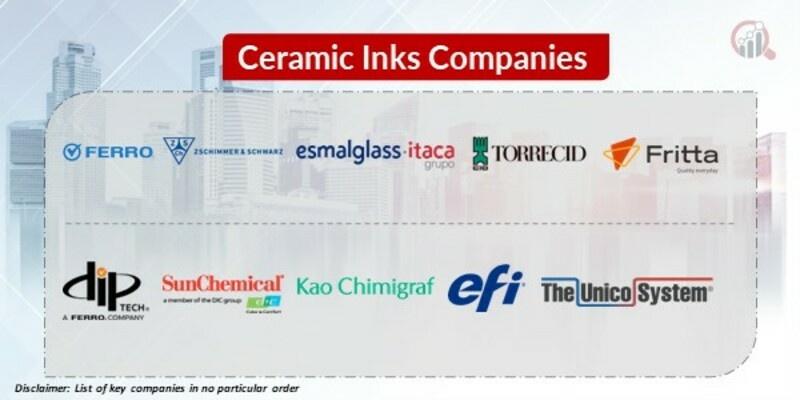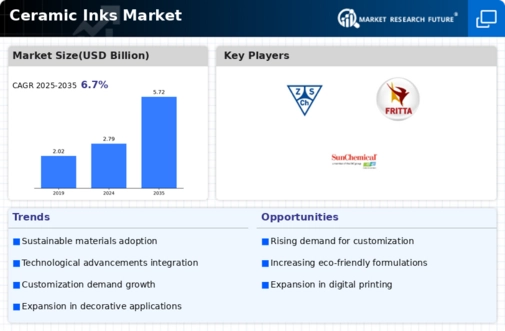Top Industry Leaders in the Ceramic Inks Market

The global ceramic inks market is a dynamic and vibrant space witnessing robust growth fueled by rising urbanization, increasing disposable incomes, and the burgeoning construction and consumer goods sectors. The landscape is teeming with a diverse range of players, from established giants to nimble newcomers, all vying for a slice of the pie. Navigating this competitive terrain requires a keen understanding of the strategies employed, market share determinants, and the latest industry developments.
Strategies Shaping the Game:
- Innovation Prowess: Leading players like Ferro Corporation, Zschimmer & Schwarz, and Esmalglass are prioritizing research & development, leading the charge in developing eco-friendly and sustainable inks, digital printing solutions, and functional inks with enhanced properties like scratch resistance and anti-bacterial effects.
- Regional Expansion: Established players are venturing into emerging markets like China, India, and Brazil, capitalizing on the rapid urbanization and burgeoning demand for high-quality ceramics in these regions. Acquisitions and strategic partnerships are facilitating this expansion, broadening their reach and customer base.
- Product Diversification: Diversifying product portfolios beyond decorative inks to embrace functional inks for applications like electronic circuits, solar cells, and medical devices is a key strategy. Companies like Torrecid Group and Fritta are actively pursuing this path, tapping into new revenue streams and market segments.
- Vertical Integration: Some players are integrating backward by acquiring raw material suppliers or forward integrating by establishing their own ceramic tile or glass printing facilities. This vertical integration ensures greater control over supply chains, improves cost efficiency, and strengthens their competitive edge.
- Sustainability Focus: The emphasis on eco-friendly inks, water-based solutions, and reduced emission processes is gaining traction. Companies are actively investing in green technologies and certifications to cater to the growing demand for sustainable products from environmentally conscious consumers.
Market Share Movers and Shakers:
- Technology Adoption: The transition from analog to digital printing is playing a pivotal role in market share dynamics. Players with advanced digital printing solutions and expertise are poised to gain an edge.
- Application Focus: Companies catering to niche applications like food container printing, electronics, and medical devices are witnessing impressive growth. Diversification beyond traditional applications broadens market reach and reduces reliance on saturated segments.
- Regional Strengths: Regional players with strong local presence and distribution networks have an advantage in their respective markets. For example, Changsha Six Star New Material Co. Ltd. holds a significant share in China due to its extensive distribution network and cost-effective solutions.
- Brand Reputation and Customer Relationships: Established brands with a strong reputation for quality, reliability, and innovation tend to attract and retain customers. Building strong customer relationships and providing excellent service are crucial for securing market share.
List of Key Players in the Ceramic Inks Market
- Ferro Corporation
- ZSCHIMMER & SCHWARZ CHEMIE GMBH
- Esmalglass-Itaca Grupo
- FRITTA
- Dip-Tech Digital Printing Technologies Ltd.
- Sun Chemical
- Changsha Six Star New Material Co. Ltd.
- KAO CHIMIGRAF SLU·
- Electronics for Imaging Inc.
- Vaanix Industries Pvt Ltd.
- IIMAK
Recent Developments:
September 2023: Grupo Colorobbia S.p.A. receives certification for its eco-friendly ceramic inks, catering to the growing demand for sustainable products.
October 2023: Electronics for Imaging Inc. and Vaanix Industries Pvt. Ltd. collaborate to develop functional inks for printed electronics, opening up new avenues for the ceramic inks market.
November 2023: The global ceramic inks market witnesses slower growth due to economic slowdown in key regions like Europe and North America.
December 2023: New regulations on lead content in ceramic inks are implemented in the European Union, impacting some producers and prompting a shift towards lead-free alternatives.









